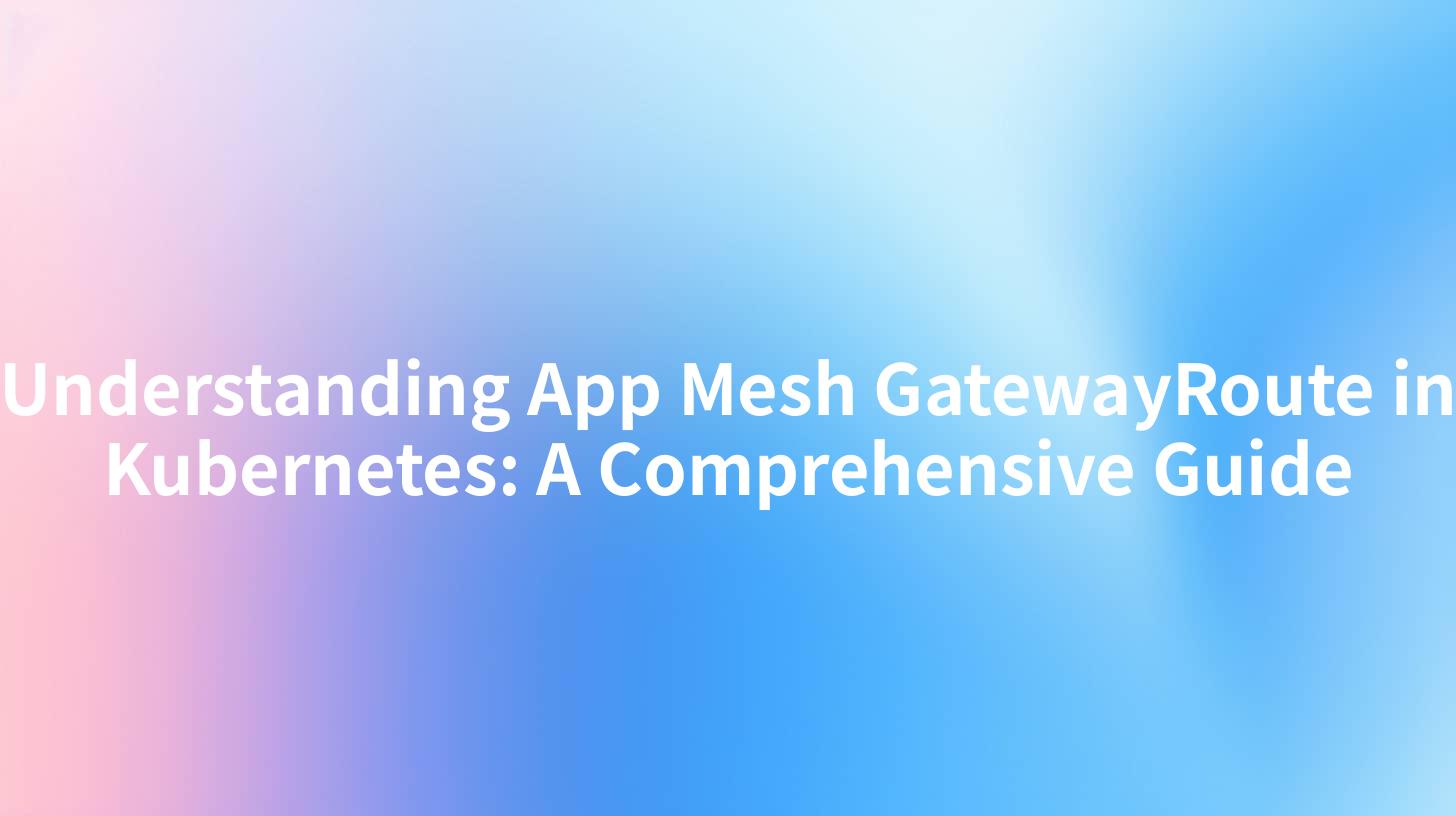Understanding App Mesh GatewayRoute in Kubernetes: A Comprehensive Guide

Understanding App Mesh GatewayRoute in Kubernetes: A Comprehensive Guide
In the realm of microservices architecture, Kubernetes has emerged as a robust orchestration platform that allows for seamless management of containerized applications. One essential component of this orchestration is the App Mesh GatewayRoute, which plays a pivotal role in managing traffic for microservices. This guide delves into the intricacies of the App Mesh GatewayRoute, its integration with AI Gateways, and the role of tools like Apigee in enhancing the functionality of Kubernetes.
What is App Mesh GatewayRoute?
App Mesh is a managed service mesh that helps to control communication between microservices. A critical part of this framework is the GatewayRoute, which provides a means to direct traffic based on various criteria, such as request headers or the source of the request. By leveraging GatewayRoute, developers can create a more resilient and efficient microservices architecture that is responsive to varying traffic patterns and workloads.
Benefits of Using App Mesh GatewayRoute
- Fine-Grained Traffic Control: GatewayRoute allows for detailed traffic management, enabling developers to route requests based on more granular elements. This means that an application can distinguish between different types of traffic and forward them to appropriate services.
- Integration with AI Solutions: Incorporating AI Gateways can significantly enhance the performance of applications by employing machine learning algorithms to optimize routing decisions continuously.
- Enhanced Security: By controlling traffic flow, you can better protect your microservices from unwanted intrusions or attacks, as you can set policies that define how traffic should be handled.
- Support for Blue/Green Deployments: GatewayRoute facilitates the implementation of blue/green deployments by allowing developers to route a percentage of traffic to new versions of microservices, thus enabling safer rollouts.
How GatewayRoute Works in Kubernetes
In Kubernetes, App Mesh integrates transparently into the platform, allowing teams to utilize its features without altering their existing application logic significantly. The following steps outline how GatewayRoute operates within Kubernetes:
Step 1: Setting Up the Gateway
Before you create the GatewayRoute, you first need to define a Gateway using a YAML configuration file. The Gateway object encapsulates the setup of the gateway and can be configured to handle incoming traffic.
apiVersion: appmesh.k8s.aws/v1beta1
kind: Gateway
metadata:
name: sample-gateway
spec:
gatewayRoute:
https:
port: 443
service: sample-service
Step 2: Creating a GatewayRoute
Once the Gateway has been set up, the next step is to define the GatewayRoute. Here's an example of how a typical GatewayRoute configuration might look:
apiVersion: appmesh.k8s.aws/v1beta1
kind: GatewayRoute
metadata:
name: sample-gateway-route
spec:
gatewayName: sample-gateway
http:
- match:
prefix: /
route:
- destination:
virtualService:
virtualServiceName: my-service
rewrite:
hostname: new-service.host
Step 3: Traffic Management with GatewayRoute
The above route matches any requests coming to the / path and forwards them to the specified virtual service. App Mesh then handles the load balancing and retry logic defined in the GatewayRoute.
Understanding AI Gateway and Apigee
Integrating an AI Gateway with Kubernetes enhances the capabilities of an application beyond what traditional service meshes can achieve. An AI Gateway can process data, make real-time decisions based on traffic patterns, and interact with machine learning models to optimize your microservices’ performance.
Role of Apigee in AI Gateway Integration
Apigee, a Google Cloud product, is designed to manage APIs. It allows organizations to create, secure, and analyze APIs using a comprehensive framework. When combined with AI Gateways, Apigee provides additional features such as:
- Analytics: Monitor API usage and performance over time.
- Security: Implement authentication and authorization mechanisms that protect sensitive data.
- API Management: Deploy an API management layer that allows for version control, traffic management, and developer engagement.
Diagram Representation
Below is a diagram illustrating the flow of traffic from users through the App Mesh Gateway to microservices, enhanced by AI capabilities.
+-------------------+
| Users |
+-------------------+
|
v
+-------------------+
| AI Gateway |
+-------------------+
|
v
+-------------------+
| App Mesh |
| GatewayRoute |
+-------------------+
|
v
+-------------------+
| Microservices |
+-------------------+
Best Practices for Implementing GatewayRoute in Kubernetes
To fully leverage the capabilities of App Mesh GatewayRoute, consider the following best practices:
- Use Versioning for Microservices: Ensure that your API design allows for versioning to make discovering services easier and safer to manage in production.
- Monitor Performance: Utilize monitoring tools to understand traffic patterns and application performance to adjust GatewayRoutes as needed.
- Secure Your Gateway: Always implement multiple layers of security, including HTTPS, authentication, and authorization mechanisms.
- Document Your Routes: Keeping thorough documentation of your GatewayRoute configurations can help reduce onboarding time for new team members and improve collaboration.
APIPark is a high-performance AI gateway that allows you to securely access the most comprehensive LLM APIs globally on the APIPark platform, including OpenAI, Anthropic, Mistral, Llama2, Google Gemini, and more.Try APIPark now! 👇👇👇
Conclusion
App Mesh GatewayRoute is a potent feature within Kubernetes, providing teams with the tools they need for fine-grained traffic management and routing in microservices architectures. By combining this capability with AI Gateways and API management tools like Apigee, organizations can enhance their service resilience, improve performance, and ensure a better experience for end-users. As you start integrating App Mesh GatewayRoute into your applications, remember to leverage best practices and monitor your system to optimize the performance of your microservices architecture effectively.
By understanding and implementing the concepts laid out in this guide, you can ensure that your Kubernetes deployments not only meet the demands of today’s applications but are well-prepared to adapt to the future.
🚀You can securely and efficiently call the 通义千问 API on APIPark in just two steps:
Step 1: Deploy the APIPark AI gateway in 5 minutes.
APIPark is developed based on Golang, offering strong product performance and low development and maintenance costs. You can deploy APIPark with a single command line.
curl -sSO https://download.apipark.com/install/quick-start.sh; bash quick-start.sh

In my experience, you can see the successful deployment interface within 5 to 10 minutes. Then, you can log in to APIPark using your account.

Step 2: Call the 通义千问 API.


